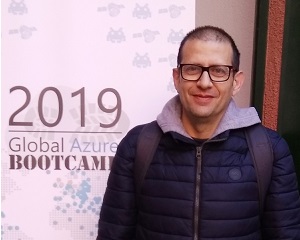Actualmente no existe un libro oficial de Microsoft para la preparación del examen 70-563 PRO Designing and Developing Windows Applications Using Microsoft .Net Framework 3.5.
Pero podeis utilizar el libro del examen 70-548 para Net Framework 2.0 que es totalmente válido y incluye todo el temario para presentarse al examen con garantias.
Temas principales del examen:
- Imaginando y diseñando una aplicación
- Diseño y desarrollo de la interfaz de usuario
- Diseño y desarrollo de los componentes
- Diseño y desarrollo del Application Framework
- Implementación de la aplicación
- Comprobación y estabilización de una aplicación
- Depliegue y Soporte de la aplicación
Recordar que este post, no sustituye al libro oficial, lo más importante que debéis tener en cuenta a la hora de preparar el examen son estos 3 aspectos:
- Imprescindible leer el libro del examen
- Realizar los labs y prácticas del libro
- Realizar tests para preparar el Examen.
Una sugerencia personal, ir tema por tema, hasta llegar al final del libro, el tiempo estimado se calcula en 1-3 meses y se recomienda llevar programando entre 2 y 3 años en WinForms para presentarse al examen.

El libro esta diseñado para cubrir todos los temas del examen que sirven como guía rápida.
1. Application Requirements and Design
- Evaluate Requirements and Propose a Design
- Business Requirement
- User Requirement
- Functional Requirement
- Quality of Service Requirement
- Use Cases vs Requirements
- Recommend the Best Technologies for the Application
- Create a High-Level Application Design
- Create a Mockups Prototypes
- Create a Proof-of-Concept Prototypes
- Define User Interface Elements to Confirm Requirements
- Confirm and Refine the Recommended Architecture
- Demonstrate the Feasibility of the Design
2. Decompose Specifications for Developers
- Create a Logical Model – Define Objects and Their Relationships
- Determine Object Role Modeling (ORM) diagram
- Determine Objects, Relationship, Facts, Constraints, cardinality.
- Determine logical relationships between objects.
- Determine attributes: Identify Objects, Properties, Methods, Entities and Fields
- Create a Logical Architecture – Define Application Layers
- Define the Layers & Communication of Your Windows Application
- Presentation Layer (UI, UX, interface code, interaction code)
- Business Layer (Middle Tier : services, rules, validation, domain)
- Database Layer (Infrastructure Tier: ado, repository, tables, sp, integration, etc)
- Create Phisycal Models for Developers (UML, CD, Visio)
- Component Diagram (Defining Application Components)
- Class Diagram (Define Classes for Your Application)
- Sequence and collaboration diagrams
- Activity Diagram
- Create pseudo code to aid developers.
3. Evaluation the Logical & Phisycal Design
- Evaluating the Logical Design and Phisycal Design
- Performance, Maintainability, Extensibility, Scalability, Security, Data Integrity
- Evaluate Design vs Use Cases
- Location of files of the application
4. Define a Common User Interface Layout
- Evaluate Requirements for the Visual Interface
- Choose Layout for the Visual Interface
- Goals UI (Accessible, Easy to use, Inductive, Responsive, Efficient, Rich and Powerful)
- User Navigation (Menu, ToolBar, Context menus, Tabs, Buttons, Action Panels)
- Define a Strategy to Implement a Common UI Layout
- Single-Document Interface (SDI)
- Multiple-Document Interface (MDI)
- Define UI Layouts for SDI and MDI Applications
- Understand and Standardize Control Usage
- Create Controls for Users to Enter Data
- Creating Containers for Other Controls
- Displaying Data and Application Information
- Displaying Graphics and Using Audio
- Displaying Common Dialog Boxes
5. Validation and User Feedback
- Validating Data in Application
- Data-Format Validation in Controls
- Business Rule Validation in Classes
- Data Binding and Validation With DataSets
- Data Binding and Validation with Business Objects
- IDataErrorInfo interface
- INotifyPropertyChanged Interface
- Providing Feedback to Users
- Feedback Options (Status Bar, Tool Tips, MBox, ErrorProvider)
6. Component Design
- Database Design (Schema, Data Entities, PKs, FKs, Index, etc)
- Designing Components (Forms and set of components)
- Component Features (Interface, constructor, methods, properties and events)
7. Component Development
- Implementing Component Features (Extend, Compose, Implement, Stateful or Stateless)
- Developing Data Access Components(implement CRUD functionality, Commands & DataReaders)
- Component Infrastructure (exception handling and profiling support)
8. Instrumenting Your Application
- When Should an Application Be Instrumented ( Logging, Monitoring, Security)
- Storing the Data (textfile, Database, EventLog, email, etc)
- Using an Instrumentation Framework (Enterprise Library, Monitor)
9. Building Components
- Make, Buy or Extend (Factors that lead to the decision)
- Implementation Practices (StringBuilder, StringFormat, Stored Procedures, etc)
10. Handling Exceptions
- Goals of Exception Handling (Construct a mechanism to handle/log «bad» exceptions)
- Application-Wide Exception (Use Exception Handling Application Block)
11. Application Configuration
- What Should Be Stored? (Security, Encryption, Locating User/App)
- Choices for Persistence (Physical Files, Isolated Storage, Database, Registry)
- Formatting Settings (String-Formatted, XML-Formatted, Binary)
12. Define and Evaluate a Testing Strategy
- Creating a Unit Testing Strategy (Unit Testing & Code Coverage)
- Integration, Load, Stress and Performance Test (Evaluate Test Lab)
13. Creating Development Tests
- Creating Effective Unit Tests (Creating Test Cases)
- Performing a Code Review (improve quality of code and best practices)
- Evaluating and Fixing a Bug (Testers find and document bugs to developers)
14. Deploying an Application
- Deploying Application (Elements of Deployment)
- Deployment Methods (XCopy, Windows Installer, Click Once)
- Deployment Dependencies (WinServices, WS, COM+, Networks, Database)
15. Supporting an Application
- You Can Tune an Application
- Performance Information and Counters
- Application Flow-Logic Diagrams
16. Multimedia in Windows Applications
- Choosing a Delivery Format (Audio and Video Formats)
- Building a Delivery Mechanism (system.Media, WAV, MCI, DirectShow)
Información del Examen 70-563
Página Oficial y Skills Measured














